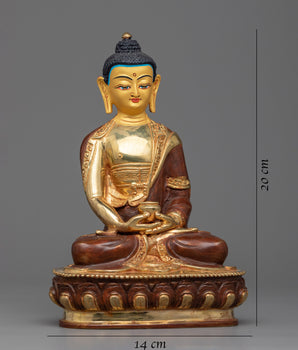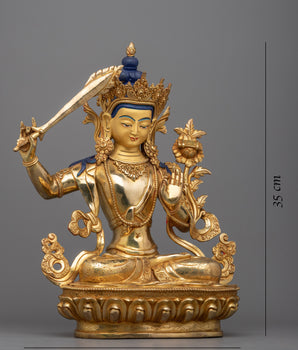Brass and Silver Filigree: A Distinctive Art Form of Nepal
Brass and silver filigree is a unique hallmark of Nepalese craftsmanship, showcasing intricate metalwork in religious artifacts, jewelry, and decor. This delicate artistry reflects Nepal’s rich cultural heritage and skilled artisanship. Nepal, a land of ancient heritage and exquisite artistry, is home to some of the most intricate and time-honored metalwork traditions in the world. Among these, brass and silver filigree stand out as a distinctive hallmark of Nepalese craftsmanship, embodying both precision and elegance. These delicate yet complex designs, skillfully woven into metal, highlight the extraordinary talent of Nepalese artisans who have preserved and refined their craft over generations.
From the grand embellishments on centuries-old temples to the fine detailing in modern jewelry, filigree work in Nepal has retained its charm and cultural significance. Whether adorning religious artifacts, enhancing decorative pieces, or shaping contemporary accessories, this intricate metalwork reflects Nepal’s rich artistic legacy and deep-rooted traditions.
This blog delves into the captivating world of Nepalese brass and silver filigree, exploring its historical evolution, meticulous crafting techniques, cultural importance, and its seamless adaptation into modern art and design.
The History of Filigree in Nepal

The art of filigree in Nepal can be traced back over a thousand years. Influenced by Indian, Tibetan, and Newari metalworking traditions, Nepalese filigree has developed its own distinct identity. Ancient inscriptions and historical records indicate that Nepalese artisans were sought after by royal courts and temples across South Asia for their mastery of metalwork.
During the Malla period (12th-18th century), the Kathmandu Valley became a hub for metal artisans. Kings and noble families commissioned intricate brass and silver filigree work for temple decorations, idols, and ceremonial objects. This era saw the golden age of Nepalese metalwork, with workshops flourishing in cities like Patan, Bhaktapur, and Kathmandu.
Even today, traditional filigree techniques are carefully preserved, passed down through generations of skilled artisans, ensuring that this exquisite craft remains alive.

The Unique Techniques Behind Nepalese Filigree
1. Metal Selection and Preparation
Nepalese filigree work primarily incorporates brass, silver, and occasionally gold, each chosen for its unique properties and applications. Brass, known for its durability, is widely used in crafting larger artifacts, religious items, and ceremonial objects. Silver, on the other hand, is favored for its delicate nature, making it the ideal choice for intricate jewelry, ornamental designs, and fine decorative pieces. Gold, though less common, is sometimes incorporated to add luxury and value to select creations, further showcasing the exquisite craftsmanship of Nepalese artisans.
2. Wire Drawing and Twisting
The defining characteristic of filigree is the use of fine metal wires, which are meticulously drawn, twisted, and coiled to create intricate, lace-like patterns. Master artisans skillfully shape these delicate wires into elaborate floral motifs, symmetrical geometric patterns, and sacred religious symbols, each design reflecting a deep sense of craftsmanship and cultural significance. The precision required for this art form demonstrates not only technical expertise but also a refined artistic sensibility, making filigree a true testament to the dedication and skill of Nepalese artisans.
3. Soldering and Assembly
Once the intricate wire patterns are meticulously shaped, they are carefully soldered onto a metal base using a high-temperature flame. This delicate process demands immense patience, precision, and skill, as even a slight excess of heat can cause the fine wires to melt or lose their intricate design. After the soldering is complete, the pieces undergo a thorough refinement process, where any imperfections are smoothed out. Finally, they are meticulously polished to enhance their luster and bring out the intricate beauty of the filigree work, making each piece a true masterpiece of craftsmanship.
4. Embellishments and Finishing Touches
Many filigree items are further embellished with semi-precious stones, gold plating, or intricate engravings, adding layers of detail and sophistication. These exquisite finishing touches not only enhance the visual appeal but also elevate the artistic and cultural value of each piece, making them even more captivating and treasured.
Challenges Faced by Nepalese Filigree Artisans
While the filigree craft is admired for its beauty and historical value, Nepalese artisans face several challenges that threaten its sustainability:
-
Declining Number of Skilled Artisans: Younger generations are progressively steering away from traditional filigree work, as they find it to be an extremely intricate and time-intensive craft that demands a high level of skill and patience. Moreover, the financial returns in this field are often insufficient when compared to the effort and dedication required, making it a less appealing career choice.
-
Competition from Machine-Made Jewelry: The widespread availability of mass-produced, affordable jewelry from foreign markets has significantly impacted consumer demand for intricately crafted handmade filigree items. As these factory-made pieces offer lower prices and a variety of styles, many customers opt for them over the more time-intensive and delicate artistry of traditional filigree work.
-
Rising Costs of Raw Materials: The ever-changing and unpredictable prices of silver and brass create significant challenges for artisans, making it increasingly difficult for them to sustain their craft over time. The volatility in the market forces them to constantly adapt, often struggling to balance affordability with the quality of their work.
-
Lack of Market Exposure: Many skilled artisans face significant challenges when it comes to effectively marketing their handcrafted products, often due to a lack of resources, digital expertise, or access to broader marketplaces.
Sustainability and Ethical Craftsmanship

In recent years, there has been a growing movement toward sustainable and ethical craftsmanship in Nepal. Many artisans are now using recycled metals and eco-friendly techniques to reduce environmental impact. Ethical sourcing of materials ensures that filigree production remains environmentally conscious while supporting fair wages and safe working conditions for craftsmen.
Organizations and cooperatives are also stepping in to provide financial support, training programs, and global marketing opportunities for Nepalese filigree artisans. By promoting ethical craftsmanship, these initiatives help preserve Nepal’s metalworking heritage and create sustainable livelihoods for artisans and their families.
Cultural and Religious Significance of Filigree in Nepal

1. Filigree in Nepalese Temples and Monasteries
Throughout Nepalese temples, along with monasteries, brass and silver filigree elements are extensively used. Elaborate filigree decorations with sacred motifs, including lotus flowers and mandalas as well as Buddhist symbols, embellish numerous temple doors while also dressing up window frames and deity statues.
The Golden Gate at Bhaktpur Durbar Square represents a prime example of metal craftsmanship through its ornamentation of brass filigree work. Many Buddhist stupas, along with monasteries, display silver-plated filigree decorations that represent the sacred bond between religious practice and metal craftsmanship.
2. Filigree in Traditional Jewelry and Ornaments
Artists who practice the Nepalese jewelry-making traditions use filigree craftsmanship to create delicate patterns from thin wires. Newari women utilize delicately made silver filigree necklaces, earrings and bangles as central aspects of their cultural attire because they emphasize both beauty and cultural meaning. These meticulously made ornaments serve to make people more beautiful while maintaining spiritual values together with social meanings as they continue from generation to generation as valued family possessions.
Popular filigree jewelry includes:
-
Timila (traditional silver headpiece)
-
Kanthas (filigree chokers)
-
Hasi (pendants with detailed silverwork)
Each meticulously crafted piece tells a rich story of Nepalese heritage, reflecting centuries of artistic tradition, cultural symbolism, and skilled craftsmanship.
3. Filigree in Ritual Objects and Offerings
The religious rituals of Nepal include sacred objects crafted from filigree that consist of butter lamps and offering bowls and incense holders. Exquisite filigree pieces are ordinarily decorated with Tibetan and Hindu motifs, which stand as divine symbols along with spiritual meanings. These items perform both religious functions of worship and meditation and display the profound artistic essence alongside the cultural legacy of Nepal.
The Craftsmanship Behind spFiligree

Creating brass and silver filigree requires intensive effort together with extensive intricate detail that needs both excellent skill and absolute precision alongside long-term patience. Artisans working in Nepalese family businesses carefully develop every piece by passing on techniques that have evolved over multiple generations. Craftsmen preserve these classic production approaches through generations of cultural heritage to safeguard brass and silver filigree as an honored element of Nepal’s cultural wealth.
1. Metal Preparation
Top brass and silver quality selection initializes the production process while delivering both sustainability and visual attractiveness. After melting down the selected metal, it becomes thin, flexible wires through an intricate drawing process. Both the skillful twining process and expert braiding and coiling techniques are used by experienced artisans to create dainty patterns with metal wires. The artisans apply their careful detailing knowledge during the initial creation, which supports the completion of complex refined patterns.
2. Design and Framework Creation
The artisan starts with an exact drawing of the planned design that can be done either with paper or directly on metal before creating both structural precision and symmetry. A solid framework accomplishes support functions using thick wires, which create the essential construction basis of the piece. The framework of the piece provides structural support until delicate filigree patterns made from intricately twisted soldered metal wires become attached to transform the design into a masterpiece of craftsmanship.
3. Intricate Wirework and Soldering
Seamless metal wire structures emerge after skilled craftsmen arrange and form elaborate floral, geometric and traditional motifs through detailed work. An artisan utilizes small soldering tools to fuse elements together in a precise manner for creating smooth connections along with delicate part details. Extensive focus together with controlled hand movements becomes necessary during this phase because tentative movements and improper heat application might ruin either the component's appearance or its overall structural integrity. The artisan demonstrates commitment to traditional filigree preservation through their extensive and complicated work methods.
The Future of Nepalese Filigree Craftsmanship

Brass and silver filigree craftsmanship in Nepal depends on three key factors, including innovation and market awareness expansion alongside product development. Nepalese artisans now have a chance to display their artistry to customers worldwide since people increasingly expect custom handmade products. Due to the emergence of e-commerce platforms, Nepalese filigree work has become more available to international customers who want to purchase culturally important handmade products. The digital evolution enables Nepalese craftspeople to grow their audience and maintain their source of income by connecting to consumers from regions outside their immediate local market.
Central to brass and silver filigree preservation stands the support from governmental initiatives through various preserving and promotional activities. Strategic government policies that care for small-scale artisans while providing funding opportunities and facilitating skill training will strengthen the sustainability of brass and silver filigree work. The worldwide acceptance of Nepalese filigree artisans can be achieved through tourism-driven craft fairs and cultural exchange initiatives and international exhibitions, as these programs will bring collectors and designers who value the detailed craftsmanship and historical heritage of these works.
The preservation of this art tradition needs younger generations to become involved with metal craftsmanship. Educational institutions should establish vocational training and workshops, which will prompt new artisans to maintain traditional methods as they adopt modern design perspectives. Modern fashion designers, together with fashion brands, should join forces on joint projects to promote Nepalese filigree craftsmanship through jewelry making and decorative items and high-end luxury accessories, thus aligning it with evolving consumer lifestyle tastes.
Modern Adaptations of Nepalese Filigree Work

1. Contemporary Jewelry and Fashion Accessories
The New Age interest in handcrafted goods has driven Nepalese filigree into modern jewelry markets worldwide. Unfortunately, research information on Kathmandu Valley industry trends is lacking. Yet some designers expertly weave intricate filigree work into minimalist earrings as well as bold statement rings and exquisite bridal jewelry by uniting traditional handiwork with fashionable design elements. The combination of traditional techniques with contemporary design enables Nepal to make filigree both commercially desirable for high-end and casual jewelry collections that are available globally.
Popular modern filigree designs include:
-
Geometric silver filigree rings
-
Brass filigree cuff bracelets
-
Bohemian-style filigree earrings
These contemporary designs captivate both locals and international buyers who deeply appreciate Nepal’s rich craftsmanship, intricate artistry, and cultural heritage.
2. Filigree in Home Decor and Interior Design
The intricate filigree work now finds its place in multiple home decor items such as lampshades, mirrors, decorative wall panels and furniture accents. Handcrafted products made from filigree art bring sophistication through traditional Nepalese techniques that fit modern interior schemes. Filigree techniques from the past persist while new decorative uses expand the traditional art of Nepal to reveal its artistic heritage in modern, fresh ways.
Challenges and the Future of Nepalese Filigree

The Nepalese artisans have started to embrace sustainable manufacturing by incorporating environmentally friendly processes that bring recycled materials into their intricate filigree development. The movement toward sustainable work ethics protects traditional art methods from extinction and gives social stability and long-term financial stability to local neighborhoods. The artisans in Nepal support responsible sourcing, waste reduction and eco-friendly practices to ensure continuous preservation of their filigree art traditions while creating sustainable outcomes for future generations.
Conclusion: The Timeless Beauty of Nepalese Filigree
Brass and silver filigree functions as an exemplary artifact of Nepal’s exceptional craftsmanship because it connects tradition with cultural values and art traditions. The delicate and intricate metalwork serves as a fundamental part of Nepalese heritage since it appeared centuries ago to decorate temple doors and ceremonial objects and decorative items as well as fine jewelry. Artisan dedication through many generations showcases itself in these masterworks, which need exceptional skill combined with patience.
Handmade ethical craftsmanship remains important as modernization and change in consumer tastes do not diminish the appreciation for sustainable actual craftsmanship. The increased appreciation of Nepalese filigree arts gives reasons to believe these delicate craft traditions will stay relevant in modern times. Nepalese artistic heritage through filigree will persist because skilled artisans actively share their expertise while they create modern designs for new consumer markets.
Nepalese filigree gives art lovers and jewelry enthusiasts more than visual beauty because it showcases an enduring cultural craft throughout historic time. Through appropriate recognition and appreciation, there exists an opportunity for Nepalese filigree to be admired and cherished by perpetuity.















